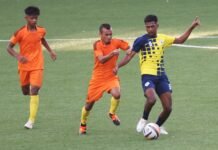Winning is a habit and after a year of disappointment Lajong finally won the U-18 SPL. Rangdajied, on the hand, came close but were unable to overcome their old nemesis, falling at the final hurdle yet again.
This has been the story of Rangdajied for the last few years now: always the bridesmaid, never the bride. Were they equipped to defeat Lajong today, absolutely. So why couldn’t they? Some may suggest that they have a mental block when it comes to getting the job done. Looking at the performance of the senior team in the last two seasons when they lost crucial matches that they should have won, mental frailty could be an issue. If you have a habit of winning, you find a way to come back even from losing situations. Manchester City have been a very dominant force in the Premier League for the last two seasons. However not all wins were entirely straightforward. There were games when Raheem Sterling scored some last minute goals to get important points for his team. Champions always find a way to win.
Rangdajied’s case is the opposite. Even when they start as favourites they find a way to lose the match. This happened in the 2017 SPL final against Langsning and 2018 SPL semifinal against Lajong. Mental frailty, therefore, could be an issue. However, Saturday’s loss is more of wrong tactics being employed, especially in the first half and in regard to certain players.
As pointed out, despite being the top scorer of the tournament Oresterwell Langshiang has failed to score against teams from the upper end of the table. This trend was extended in the final as well. However, it would be wrong to measure his quality based only on goals scored. He creates a plethora of chances and attracts opposition defenders, creating space for his team mates who can then get into dangerous positions. In the final his skill was for all to see. He even had a couple of shots at goal, both of which created some discomfort for Lajong’s goalkeeper Urbanity Makhroh. The first one was a strike from outside the box that bounced in front of the goalkeeper, which almost allowed Rangdajied’s striker to pounce on the mistake. With support from Kitboklang Khyriem the threat was averted. The other was, again, a shot from outside the box which Urbanity was able to punch away from goal.
Though he looked a little low on confidence, Urbanity made some good saves which ensured that Lajong were able to hold on to their advantage. Despite hobbling during the middle of the first half Oresterwell came back stronger after the injury scare and kept trying his best to get the win for his team. He, though, was let down by the team’s tactics.
I just cannot understand the rationale behind playing Oresterwell as the central striker. Maybe the plan was to play him as a false nine and try to pull the defence away, creating space for others like Donboklang Mawlong and Bankyrshan L Mawphlang to make their runs. However, that was not going to be achieved by pumping in long balls which Lajong’s central defence pairing of Aman Ahlawat and Henryford Nongneng easily dealt with. With Rangdajied’s midfielder also not moving up there was no chance of winning the second ball as well. Realising that the game-plan was not working Oresterwell was shifted to the left with Donboklang moving to the centre.
Deep into the second half Oresterwell’s position again changed. This time he was moved to the centre of the midfield to occupy the role of the playmaker. This changing of positions shows that the coach is not really sure of Oresterwell’s best playing position, which is a shame because he is a kind of player who can change the course of the game. For me his best position is as a deep lying playmaker where he can have more of the ball and control the game for his team. This makes the team so much better because he has a very wide passing range which can find team mates on any part of the pitch. Played out of position he almost got his team back when he was fouled inside the box. The referee, though, decided that it was not a penalty but a free-kick, which Rangdajied squandered.
The quality Oresterwell has is something very few possess and I hope as he matures as a player he is played in his best position. I believe if he has handled properly he will be a very special player in the future.
Coming to the tactics again, the 4-3-3 that Rangdajied employed was a good system but by bypassing the midfield altogether in the first half its effectiveness was limited. In the second half this was changed and the team looked calmer and assured in possession. The players who helped Rangdajied gain more control in the game were Balamlynti Khongjee and Knerkitlang Buam. Both players worked very hard for their team, breaking up Lajong’s attack and circulating the ball very neatly. On the right side Bankyrshan gave a torrid time to Lajong’s left back while Oresterwell was doing the same to Kitboklang on the left. However, when it came to the final third a cutting edge was lacking. Donboklang is a tenacious player but not a prolific goal scorer.
In the first half when he got a chance to shoot his shot was way off target. He engaged the central defenders very well and occasionally dropped back to help with the midfield. As a striker, though, he has not been as potent as is expected from someone playing in the advanced position. This could be an area of concern for Rangdajied in the senior SPL as well.
They have signed Donlad Diengdoh who is a hardworking striker but is again not prolific. At Langsning Donlad played in a system which allowed Kitboklang Pale and others to get into scoring positions though he himself didn’t score many. Unless Rangdajied are able to find goals from somewhere else their inability to score will come back to haunt them again this season.
However, in this particular match it would be wrong to single out Donboklang for his awry shooting. Almost everyone got a chance to have a go at Urbanity but almost all the shots were completely off target. Balamlynti, who for me had a very good game, was also disappointing in this regard. As for the defence, George Vannie L Nongrang and Starjune Jana put in some last ditch tackles and defended their goal valiantly.
In the second half the team played much better but by then Lajong had already scored the goal, which meant that Rangdajied were always playing catch-up. As for their tactics, Lajong were spot on from the beginning of the match.
Lajong lined up with a 4-4-2 with Dajiedlang Wanshong and Amon Lepcha leading the line. Though both the strikers were comparatively taller than Rangdajied’s defenders, balls were played into the channels rather than pumped long through the middle. Amon would constantly drift to the right while Dajiedlang would float to the left, pulling defenders out of position. The one thing that Lajong did very well was that they had runners from the midfield who would attack the box to take advantage of any lapse in defence. In this Sangti Janai Shianglong was very prominent. He’s a fleet-footed player who can run past the defence while also having the ability to play defence splitting passes. Very early in the match he provided an excellent ball to Amon, which could have proved very dangerous for Rangdajied.
The 4-4-2 that Lajong played was not meant to stretch the play but to congest the middle of the pitch. Instead of wide players they had four central midfielders with Sangti at the tip of the midfield diamond. While defending this shape transforms into two banks of four giving the team a solid defensive shape. When a delightful through ball was fed to Amon he crossed the ball which fell perfectly at Dajiedlang’s feet. Rangdajied’s defenders quickly closed down the shot but the loose ball was pounced by Sangti who scored the only goal of the match. He is a slippery player who can switch directions at any instance and leave the opposition defenders befuddled. I think I will call him Slippery Sangti because of this ability. His other midfield partners – Gladdy N Kharbuli, Skillfull Tariang and Hame Damanbha Wahlang – overloaded the centre of the pitch ensuring Lajong bossed possession. It was the defensive play of Lajong which was particularly very impressive.
The moment that ball was in the final third with an opposition player trying to find a way through, Lajong’s midfielders would swamp the player. Creating overloads, they either dispossessed the player or forced him to play back. The pressing implemented by Lajong was highly effective. This could also be a reason why so many of Rangdajied’s shots were from outside the box. The high aggression did mean that in the later stages of the game some very silly free-kicks were conceded, which, if taken properly, could have spelt danger for Lajong. The only thing which did not go to plan was the full backs not providing the width.
With the formation being very narrow the only width that Lajong had was from their full backs, especially Kitboklang, who loves to bomb forward and cross the ball. Because of the threat of Oresterwell he was kept in check and played much deeper. When Oresterwell moved to the middle of the pitch he finally got the chance to sprint forward and delivered a dangerous cross into the box. Because Lajong had scored an early goal there was not much need for Kitboklang or Saveme Tariang to push forward. In case the game had panned out differently this lack of width could have made things difficult for Lajong.
Lajong are back to winning ways, which makes the upcoming senior SPL a very exciting one. Ryntih already have made a statement by winning two trophies after winning the direct entry. With Hering Shangpliang in charge, Langsning will not be pushovers. Newly-promoted Laban have some quality players. And lastly, Rangdajied, as always, will always vie for the trophy. Will this triumph be enough to galvanise Lajong to get back to winnings ways or is this Rangdajied’s year after many years of disappointment? Time will tell. In the meantime I would like to congratulate Lajong for winning the U-18 SPL trophy, which they thoroughly deserved and Rangdajied for giving a good fight. I would like to wish all the best to both teams and their players for the future. I believe Meghalaya football is in very good hands.
(TSR photo)














